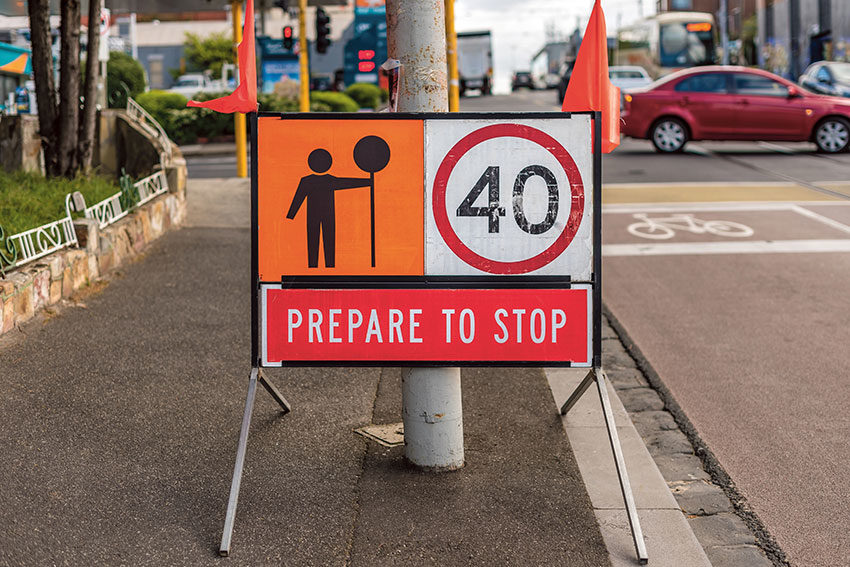Montefiore: For whom does the mob rule?

Adelaide in 2019 still exhibits displays of power randomly and sometimes contemptuously exercised.
A lifetime observing features of the street has taught Sir Monty that individuals rarely have the courage of the mob, but when they realise they’ve reached a critical mass everything can be different. It’s unusual to see an Adelaide mob taking over local streets, testing that thing called temporary manipulative power, as seen recently in Hong Kong. Usually it only goes as far as protest on the steps of parliament, where things run to an outraged but generally well behaved script before the crowd melts away leaving nothing but a megaphone echo.
But Adelaide does have two active mobs. Instead of shouts and protests, their power is exercised quietly, but insensitively and sometimes grossly so, notwithstanding lawful presence. Commuters observe them daily, street mobs in orange vests dominating key thoroughfares. Their ability to exert stress is significant. Their presence not only confronts drivers on random roads but also street-front businesses trading near major building sites. Allow Sir Monty to explain.
As a club man, he rarely ventures out. But occasionally he extracts his 2004 Morgan two-seater Roadster from storage to take brief sojourns about the city streets, if only to keep the oil circulating and the seals tight. In doing so, within minutes and with monotonous regularity it becomes clear to him that mobs of Adelaide road workers have the power to assume significant random power over traffic flow, trashing drivers’ commuting schedules in the process. They do this simply by erecting ‘merge’ signs only metres from trenches and pits that they’ve just dug in the bitumen. Predictable and infuriating gridlocks rapidly build up as multiple lanes of hundreds of cars are suddenly forced to merge to one lane with no prior signage warning of the looming blockage. Before drivers are aware of the trap, they’re suddenly stuck in it, with no escape.
The most disturbing aspect is that neither Town Hall nor state parliament appears to be the least concerned about what is a form of road worker piracy, imposing an anarchy of traffic chaos at whim, the consequences of which the guilty parties care not a jot as they stand around chatting. To put this into broader context, it reflects major growth in demand for more fresh bitumen, pipes and wires across the city as Adelaide morphs from small country town to small country city. This occurs not only around the road network but also adjacent to it, in terms of the seemingly endless expansion upward of new, multi-storey towers that have changed Adelaide’s skyline in a few short years, trashing many low-scale historic streetscapes in a contempt of dust and smashed bricks.
It is in regard to the slow construction of the replacements, those soaring concrete, steel and glass towers, that another form of construction yellow-vest mob piracy is thriving, displaying an unfettered and sometimes catastrophic influence over the viability of some adjacent businesses. Sir Monty’s club colleagues ponder why state parliament hasn’t acted by now, given plenty of evidence of small-trader economic damage and a trail of adjacent businesses that have failed because their customers have given up trying to get to them as street parking spaces disappear. But as Sir Monty has learned, it is precisely because of recent legislation created by the former state parliamentary mob, and now being enacted by the current state parliamentary mob, that the problem exists. That legislation is the Planning, Development and Infrastructure (PDI) Act 2016, which prompts proponents of major high rise development to seek a permit to alter a public road to make construction feasible, but in the process allows them to block parts or whole sections of city streets and bring in cranes, scaffolding, pedestrian fencing and hoardings.
There is other legislation, the Local Government Act 1999, which demands that the builder consult first with adjacent businesses, whose traders are heavily dependent on their street traffic customers. But under that Act there’s no requirement for the builders to adequately consult and, even if they do, there’s often woefully inadequate time allowed for the business managers to negotiate a fair outcome. Those unlucky enough to be trading near the sites of these proposed high-rise developments have been prey to the indifference of the construction mob. Town Hall expiation fees for breaching permit conditions can be pitifully small. For example, if a mob of development investors gets approval to construct, say, a $15m high rise over 12 months of city street occupation, but breaches the permit conditions, the fine can be as low as $250. Chickenfeed.
Notwithstanding the LG Act’s provisions, a schedule to the new PDI Act section soon to kick in relating to the development approval process will make redundant the need for any separate permission to block roads and other areas surrounding the building site. An alteration of a public road for business purposes is to be approved as part of the development application. In other words, the mob is left free to exercise its will, and adjacent business activity be damned.
When the club’s black-and-white movie nights present the eternal struggle between the black-hat mob and the white-hat mob, the historical narrative is always unambiguously on the white-hats prevailing. But in a curious twist on reality, what head protection do the road works and the building mobs wear? White hard hats. In the continuing evolution of a small 21st century southern city, the fair-play rules don’t run according to script.
Header image:
Shutterstock